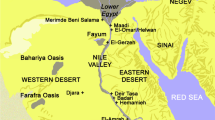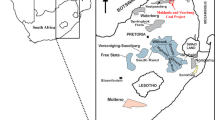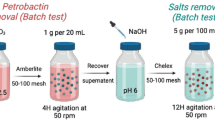Abstract
An ancient and well-developed late Shu culture was discovered in the Sichuan Basin in southwest China. For a long time, the evolution of the resource utilization of the late Shu culture has been shrouded in mystery, and it is under considerable controversy when it comes to the relationship between the late Shu culture and the Chu culture of the middle reaches of the Yangtze River. Therefore, in this paper, bronze poleaxes with characteristics of different periods, which were excavated from the Shuangyuan cemetery of the Eastern Zhou Dynasty in the Chengdu Plain, were studied by archaeological typology, portable X-ray fluorescence spectrometry (pXRF), and multi-collector inductively coupled plasma mass spectrometry (MC-ICP-MS). In contrast to previous studies, this paper achieves a further distinction among the mineral sources of a very short historical period within the long history of the late Shu culture by analyzing the local bronze poleaxes. The results show that the Shu ancestors used the same kind of lead material from the early Warring States Period to the early stage of the middle Warring States Period. However, the mineral sources of the late Shu culture underwent a significant shift in the late stage of middle Warring States Period, which was closely related to the historical background of cultural exchanges between Chu culture and Shu culture. This work indicates that the exchange between Shu and Chu gradually deepened over time during the Warring States Period.





Similar content being viewed by others
References
Cai JQ (2006) The development of social economy and culture in Chengdu Plain Before Qin Dynasty mimo-red by archaeological discovery. Jianghan Archaeol 03:50–59
Cattin F, Guénette-Beck B, Curdy P, Meisser N, Ansermet S, Hofmann B, Kündig R, Hubert V, Wörle M, Hametner K (2011) Provenance of Early Bronze Age metal artefacts in Western Switzerland using elemental and lead isotopic compositions and their possible relation with copper minerals of the nearby Valais. J Archaeol Sci 38:1221–1233. https://doi.org/10.1016/j.jas.2010.12.016
Dai LJ (2011) Bronze "yue "from Ancient Sichuan_what we call it today and how it was used in antiquity. South Ethnol Archaeol 7:211–224
Fan Y (1989) Bronze Axe and Yue in Southwest China. Acta Archaeologica Sinica 02:161–185
Frahm E, Doonan RC (2013) The technological versus methodological revolution of portable XRF in archaeology. J Archaeol Sci 40:1425–1434. https://doi.org/10.1016/j.jas.2012.10.013
Frankel D, Webb JM (2012) Pottery production and distribution in prehistoric Bronze Age Cyprus. An application of pXRF analysis. J Archaeol Sci 39:1380–1387. https://doi.org/10.1016/j.jas.2011.12.032
Huang SM (2006) Tentative Discussion of Influence of Chu Culture on the Late Shu Culture. Jianghan Archaeol 02:52–61
Hunt AM, Speakman RJ (2015) Portable XRF analysis of archaeological sediments and ceramics. J Archaeol Sci 53:626–638. https://doi.org/10.1016/j.jas.2014.11.031
Jiang ZH, Wang Y, Zhang Q (2002) A preliminary research on the predynastic Qin culture in the Chengdu plain. Acta Archaeologica Sinica 01:1–22
Jones MR (2007) Oxhide ingots, copper production, and the Mediterranean Trade in copper and other metals in the Bronze Age. Dissertation, Texas A&M University
Li XQ (2002) A brief discussion on the new archaeological discoveries in Ba Shu and their academic status - preface To "Studies on the Archaeology of Sanxingdui. J Chin Cult 03:36–37
Li HC, Zuo ZQ, Cui JF, Tian JB, Yang YD, Yi L, Zhou ZQ, Fan JN (2020) Bronze production in the Ancient Chengdu Plains: a diachronic metallurgical perspective on a separate cultural region. J Cult Herit 43:26–36. https://doi.org/10.1016/j.culher.2019.11.005
Li HC, Zuo ZQ, Cui JF, Tian JB, Yang YD, Yi L, Zhou ZQ, Fan JN (2020) Copper alloy production in the Warring States period (475–221 BCE) of the Shu state: a metallurgical study on copper alloy objects of the Baishoulu cemetery in Chengdu, China. Heritage Science 8:1–16. https://doi.org/10.1186/s40494-020-00412-0
Li DN (2003) The weapons of the Late Bashu Culture. Dissertation, Jilin University
Ling J, Stos-Gale Z (2015) Representations of oxhide ingots in Scandinavian rock art: the sketchbook of a Bronze Age traveller? Antiquity 89:191–209. https://doi.org/10.15184/aqy.2014.1
Liu ZF, Ma JC, Wang CM, Hu YW, Luo WG (2019) A lead isotope study of the fourth century B.C. bronze artifacts excavated from Guozhuang Chu graveyard in Shangcai County, Henan Province. Central China Archaeol Anthropol Sci 11:2759–2769. https://doi.org/10.1007/s12520-018-0699-2
Museum CJS (2006) The Jinsha Site. Wuzhou Communication Press, Beijing
Museum SP, Administration XCCR (1981) A wooden coffin tomb of the Warring States in Xindu, Sichuan. Cultural Relics 06, 1–16+97–103
Redfield R, Linton R, Herskovits MJ (1936) Memorandum for the study of acculturation. Am Anthropol 38:149–152. https://doi.org/10.1525/aa.1936.38.1.02a00330
Renfrew C, Bahn PG (2004) Archaeology: theories, methods and practice. Thames & Hudson, London
Snoek W, Plimer IR, Reeves S (1999) Application of Pb isotope geochemistry to the study of the corrosion products of archaeological artefacts to constrain provenance. J Geochem Explor 66:421–425. https://doi.org/10.1016/S0375-6742(99)80003-X
Song ZM (2004) Song Zhimin’s archaeological anthology. Chinese Science Publishing, Beijing
Tong EZ (1998) Ancient Ba Shu. Chongqing Publishing House, Chongqing
Wang YP (1989) The excavation of a chu-style dui in chengdu and the origin of the shu of the Kaiming. In: society CA (ed), Proceedings of the seventh annual meeting of the chinese archaeological society. Cultural Relics Publishing House, Beijing, pp 249–254
Wang TY, Chen YH, Yuan HB, Bai TY (2020) The Excavation of tomb M154 of the Easternzhou Dynasty cemetery at Shuangyuan village in Chengdu City, Sichuan. Acta Archaeologica Sinica 03, 399–403+403–428+461–476
Wei GF, Qin Y, Wang CS, Li QL, Zhang AB, Gong XC (2006) Comparative studies on Pb isotope ratios of corrosion rinds and metal cores of bronze vessels. J Univ Sci Technol China 07:771-774+792
Wen J, Ling X, Zhao CC, Zhang ZY, Yao ZQ, Zong CL, Yuan HL, Wu Z (2013) Primary analysis on lead isotope characteristics in Chu State bronzes in East-Zhou period unearthed from Liu'an District,Anhui Province. J Northwest Univ (Natural ence Edition)
Xiang MW (2020) Research on the age and relevant issues of Yanhebao Yue from Sichuan Basin. Res China’s Frontier Archaeology 01:169–185
Xu ZS, Tang JH (1981) The relationship between ancient Chu and Shu. Cultural Relics 06:17–25
Zhang YH (2006) A brief discussion of the civilizational processes in the Upper Yangtze River - focusing on the Pre-Qin culture of the Chengdu Plain, in: DUAN Y (ed), Studies in Bashu Culture 3rd series proceedings of the international symposium on new trends in ba-shu culture studies, Bashu publishing house, Chengdu, pp 65–73
Zhu B (2001) Geochemical provinces and geochemically rapid change zones. China Science Publishing, Beijing
Zhu SX (2017) An archaeological discovery of Bronze Axe in Ba-shu area and its research. J Chongqing Three Gorges Univ 33:115–121
Funding
This research is supported by the National Social Science Foundation of China (no. 20VJXG018). We are grateful to anonymous reviewers whose comments greatly improved the quality of the manuscript.
Author information
Authors and Affiliations
Corresponding author
Ethics declarations
Conflict of interest
The authors declare no competing interests.
Additional information
Publisher's Note
Springer Nature remains neutral with regard to jurisdictional claims in published maps and institutional affiliations.
Supplementary Information
Below is the link to the electronic supplementary material.
Rights and permissions
About this article
Cite this article
Wang, X., Yang, Y., Wang, T. et al. Subdivision of culture and resources: raw material transformation and cultural exchange reflected by bronze poleaxes from the Warring States sites in the Chengdu Plain. Archaeol Anthropol Sci 14, 121 (2022). https://doi.org/10.1007/s12520-022-01579-2
Received:
Accepted:
Published:
DOI: https://doi.org/10.1007/s12520-022-01579-2




